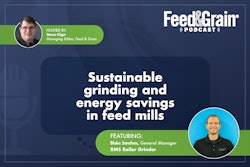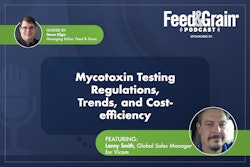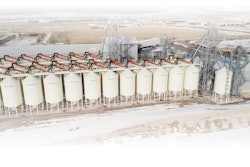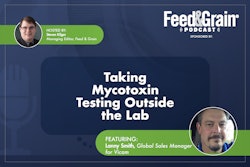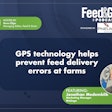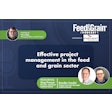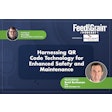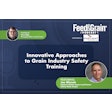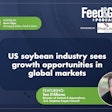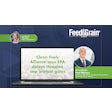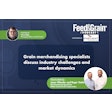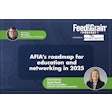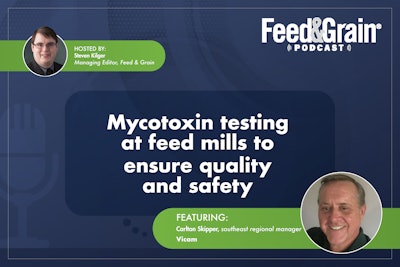
Steven Kilger, host of the Feed & Grain Podcast interviews Carlton Skipper, southeast regional manager for Vicam, a company specializing in mycotoxin testing solutions for feed manufacturing and grain handling industries.
Their discussion covers various aspects of mycotoxin testing, including its importance at feed mills and grain elevators, the advantages and challenges of employing plate mounting mycotoxin testing, and the technologies and methods used for testing.
Steven Kilger: Hi, everyone, my name is Steven Kilger. I'm the managing editor of Feed & Grain magazine and the host of the Feed & Grain Podcast. Thank you so much for joining me today as we dive deep into the issues impacting feed manufacturing, grain handling and allied industries.
Today, I'm speaking with Carlton Skipper, southeast regional manager for Vicam, we're here to talk about how to perform mycotoxin testing at feed mills in order to get the best results for you and your staff. Before we start, if you're listening to this podcast and a podcasting app, please rate us and subscribe. If you're listening online, sign up for the Feed & Grain newsletter Industry Watch to see the latest podcasts and stay up to date with all the latest news from around the industry. Thank you so much for listening. Now, on to the show ...
Thanks for coming on the podcast. Would you mind telling me and the listeners a bit more about yourself and what you do in the industry?
Carlton Skipper: Yes, sir. Hi, my name is Carlton, last name is Skipper, and I am with Vicam. I am the southeast regional manager for the region concentrating mostly on the southeast area of the United States for test kits, equipment and mycotoxin solutions.
Kilger: Thanks for being here today, Carlton, we really appreciate it. Can you provide a little bit of an overview of the importance of mycotoxin testing and feed mills, even in grain elevators, and how that can impact the quality and safety of grain and feed products?
Skipper: Well, the importance of testing at the feed mill is essential. You're looking at incoming ingredients coming into the facility that need to be checked. Then basically from there, they're going to be housed, and they're going to be stored and either used at the facility and or processed for other things such as feed. It's very important that all along that way the integrity of the product is checked. It's good for either human consumption or animal feed, and that's the task at hand when you're looking at testing at the level of feed mills.
Kilger: So what are some of the advantages and challenges and employing mycotoxin testing directly at mills? And how does this approach affect the speed and efficiency of decision making as you have new loads coming in when it's harvest time and everything's busy? How does that work?
Skipper: Well, I think that at the level of incoming, there's an awareness of the dangers associated with mycotoxin contamination. As the feed mills say they need to be doing this test. They know that. And as they seek out the solutions, I think with that comes challenges. I think from a standpoint of all the way from testing the incoming, the receiving all the way through loadout. That becomes an issue -- when do we test? How do we test and the frequency of testing? These are the challenges that are at the mill if you will, and having that conversation with the locations is -- where do we start? Where do we have that? Where are their pain points? What are they testing for? How are they testing now? And how we can provide alternative solutions here?
Kilger: Could you discuss some of the technologies and methods that are being used now out there in the field? What do people what type of tests are people normally doing at a feed mill?
Skipper: Well, the testing methodologies have really taken a turn for the better, if you will, over the course of the years that it's gone from, where they were utilizing a black light technology to today where the advancements in technique have led to lateral flow tests, tests that utilize non-toxic materials. There are many different applications. You have your lateral flow, quick tests that are out there available all the way through floor metric testing, all the way to HPLC, and a mass spec which is at the laboratory. It all depends on where that particular customer or end-user is.
If they're a smaller type of organization they may be using just a lateral flow type test that gives them a quick, reproducible answer. That gives them a good indicator of what they're dealing with when it comes to mycotoxin. contamination. There are many different providers out there of testing, but very few offer the breadth of companies such as Vicam that has an incoming test all the way through to the end test, which is at the laboratory, confirmatory test. So, there are many different solutions out there today.
Kilger: I've been in the industry for 10 years now, I think, and everything's changed so much, even in my time. There have been rapid advancements in both the quality of these tests and how accurate they are. I remember, Cargill put out their big world mycotoxin report a few months ago, and they're not sure if mycotoxins in grains are, you know, on the rise? Or if we're just testing more? Or if the tests are just getting better in finding more? Can you talk a little bit about the different types? Because you mentioned a few there? Can you kind of explain the differences?
Skipper: Yes, you have tests, such as onsite testing that are performed, for example, with the lateral flow test, a test they utilize is a non-toxic detergent, and actually just washing the sample, and from that, you get an extraction, you put that into the test, and you get a result, and that result is bankable. It is a great first indicator in the step of what that matrices are testing for. If it doesn't, indeed have contamination, they are that sensitive, the parts per billion, or in some of the tests, parts per million. They are very sensitive.
So gone are the days of as we talked about earlier, the black light type approach where it's very subjective. And a qualitative type test, which they still have qualitative tests. But here you're getting it's quantitative. It's a quantitative test. Those are the tests by which I see the industry really relying as being a good first indicator in the approach to testing at the feed mills.
Kilger: They're not as complicated as they used to be? It's not that much training to teach the people in, in the control room, the sampling room to do these, so you get really quick results?
Skipper: Absolutely. And that's a big part of it. They're not in the testing business, but the food business. I think when you take out the steps, of the many different steps that are involved in some of the testing techniques that are out there. It leads to, it could lead to confusion, it could lead to complacency and straying from the process. That is very key in when you're looking at mycotoxin test is, you know, what are the steps? Is this something that the average layman can do? Or somebody that is, like I said, in the industry has a feed mill, and they're not in the testing industry. So it really is very important.
Kilger: These guys tend to be pretty busy, so I would think in an ideal to have your truck probe, you can automate that now, so it takes multiple samples in different spots. Then you have your person, doing the test, and then moving them along. Is that kind of how you guys tend to explain the workflow to people? What is kind of the idealized workflow in a data feed mill?
Skipper: That goes back to, you have some of these locations that really have a lot of trucks. They have these trucks lined up and time is of importance. They need to get that truck unloaded, and they need a quick, reliable answer. These tests are designed now, not only can you get a quick, reliable answer, but you can stagger some of the tests where you're actually doing more than one truck at a time. That really helps in the process. They get the actionable result that they're looking for. They dump the load and they move on to the next one. That is very key in the determining if they're going to do testing or who they're going to be doing, what tests they're going to bring on board.
Kilger: There's still a place for laboratory testing, right? Especially from what I understand, if you're shipping internationally, you have to do a little bit more.
Skipper: Absolutely. I think the key here is that you want not only an actionable result, a test that will provide an actionable result, but you want that test to have, a reproducible test. You can take that reading, if you will, then if you were to take that same test down the line, you would get a like-result from an outside the laboratory. Now, of course, those findings will skew somewhat, but it should not change the prognosis, if you will, diagnosis of what you're looking at.
Kilger: What's the cost difference? Because it seems like they're also getting a lot more affordable, especially when compared to sending stuff out to the lab. Is there a little bit of savings involved if you're doing it onsite versus you know, sending it off to a lab to get samples done?
Skipper: Absolutely. I think you win on all accords, you're getting a test result at a much cheaper cost, and you're getting it in real time. So if there is a situation that needs to wait, that load needs to be diverted actionable results can take place at a little less cost. I think we win on all on all fronts there. Also, there is time to send to the laboratory for confirming things along that line. But from a first-line defense with your mycotoxin program, these tests quick tests are more than adequate. As I said, they are the first line in the defense of mycotoxin contamination testing.
Kilger: I hear people are now testing on both sides -- as grain comes in and then on the finished product, before it is stored. Which seems like a situation that wouldn't be very easy to accomplish with traditional laboratory testing.
Skipper: Well, I think availability drives in-house diagnostics testing. That's exactly right. I think if you have the ability to run a particular test, then it behooves you to at least look at that as a viable option. I think finished feed is one of those areas where there haven't been many alternative solutions other than sending it out to an outside laboratory. But now with the advent of tests from Vicam, you are able to test your finished product and get viable result and actionable results that you can work off of.
Kilger: Can you go explain a little bit about what the process is? I have a vague idea. I think a lot of people do, but after your sample grain goes into the scale house usually, someone performs the tests there. What does an employee physically have to do to be able to do a correct full test in one of these? Lateral strip?
Skipper: Lateral flow test. It all starts off with the sampling. You want to make sure you get a good sample from the truck or from whatever you're sampling. You want to get a good sample, then you're going to grind that sample down. That is key. You want a good representative sample, but then you want to take that sample and you're grinding down and in many instances, the five to 10 grams of a product. From that, you would mix an aqueous solution into a a vessel, put it on the mixer, it mixes for for 30 seconds. After 30 seconds spin down. You would put it through a filter, take 100 microliters of the extract and apply that to the test, let it incubate for five minutes, and place it in the reader. After five minutes, and you've placed it into the reader, after about 10 seconds, you get a result. You will get a number that will tell you contamination or what the level of whatever toxin that you're testing for.
Kilger: These readers can now sense more than one mycotoxin, right? Obviously, you should be generally aware of the weather conditions in your area and what mycotoxins you might run into. But they can do more than one now. Right?
Skipper: Yes. For example, if I can we have the ability from that one extraction that I spoke off that filtered amount that comes out from that filtered sample. You can run up to six different mycotoxins tests. It goes back to what we were talking about earlier the time savings rather than do six workups, on your tests, you would do one workup. From that extraction, you would be able to run six different tests, you would incubate them, and stagger them out accordingly. But you're eliminating the sampling process of grinding and spinning down. You'll you'd only have to do that one time. To answer your question: absolutely. That's where it really comes into play as a good asset to what we're doing and bringing solutions to the industry.
Kilger : I think solutions that are going to be more and more in demand is company's need to be better at record keeping in the industry, right? In having a traceability in supply chain that you can now figure out exactly where grain came from and where it's going. It seems like there's going to be more and more of a demand from end users to perform these tests, because if you're making pet food and aflatoxin gets in, there can be a disaster.
Skipper: Absolutely. That's what it is. It's a tool to help you manage your business, help traceability and help find where there is a disconnect along the line and take actionable steps to correct it. That's the beauty of what we're doing here. We're bringing those solutions that can help.
Kilger: Where should people start? When they're kind of starting to think about, oh, we need to either improve our program, update it, if it's been, you know, five years, 10 years, and you haven't changed anything, you're probably out of date, right? Where should they start that process? Reaching out to someone like you or going online? What should they do?
Skipper: Oh, I think going online is always great. We do have a website with a tutorial and will help you along. But I think you know, it starts with at the ground level, I think either you're testing or you're not testing. If you're not testing, you definitely need to get on board. There are just advancements, as we said earlier, the advancements that are currently available, make it very easy for the end user to come on board. Their risk management, the attributes, the benefits that come with mycotoxin testing, from an economic standpoint, is one of those things where it's just made it easier for the end user to come on board as far as being a viable testing center, if you will, be their own lab. I think that's how the I think the industry has evolved to where we are today.
Kilger: And continues to evolve. This is going to be the toughest question, I think. Like I said, I've been here 10 years, and it's already changed so much. Where do you see the next 10 years of mycotoxin testing going? What advancements do you think are gonna come along the line?
Skipper: First, we'll start to see more testing capabilities, different tests that come on board and we spoke earlier about how individuals are testing currently today as far as what it entails at the feed mill, and you'll have people that might be doing maybe just the one test, or maybe two tests, and they feel that is sufficient, I think that the awareness is going to grow to a point where we'll see a sort of a synergistic approach to testing where it's not just the one test that you should be doing for aflatoxin. But you shouldn't be doing the ultra toxin, you should be doing multiple tests, that really give a better picture of what you're looking at, in that sample that you're testing. And that is where I see the advancements in mycotoxin.
Kilger: Well, those are all the questions I have. Thank you so much for joining me today. If anything else you want to add?
SkippeR: No, other than I think that with mycotoxin testing, it allows just for us to really bring a needed a needed approach to food safety. It helps from a regulatory standpoint, helps the folks out there economically, from a health standpoint, and brings the best product to the people. It's a very rewarding approach to what we do to the industry, and we just look forward to being of service and an asset to the customers that we serve.
Kilger: Thank you so much, and I really enjoyed our conversation. I hope you come back again someday. And thank you again for joining me and talking a little bit about mycotoxins.
Skipper: Thank you. Appreciate it. Have a good day.


